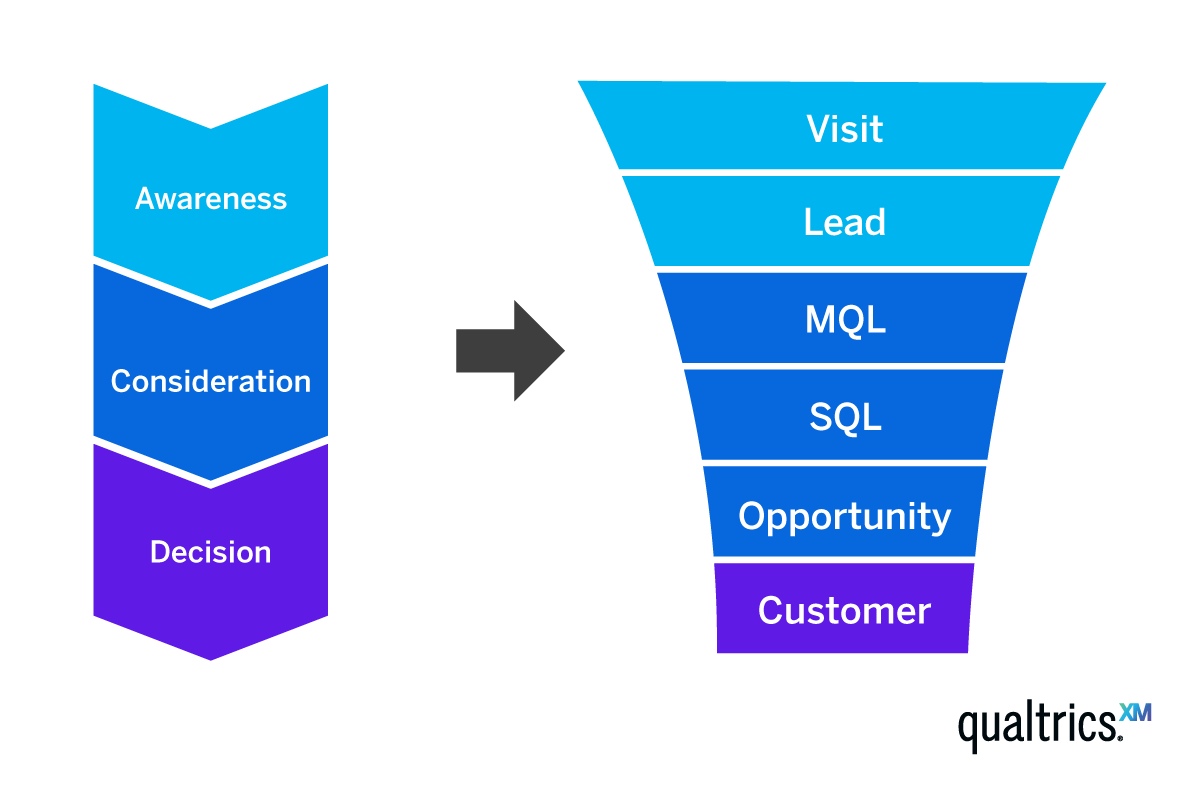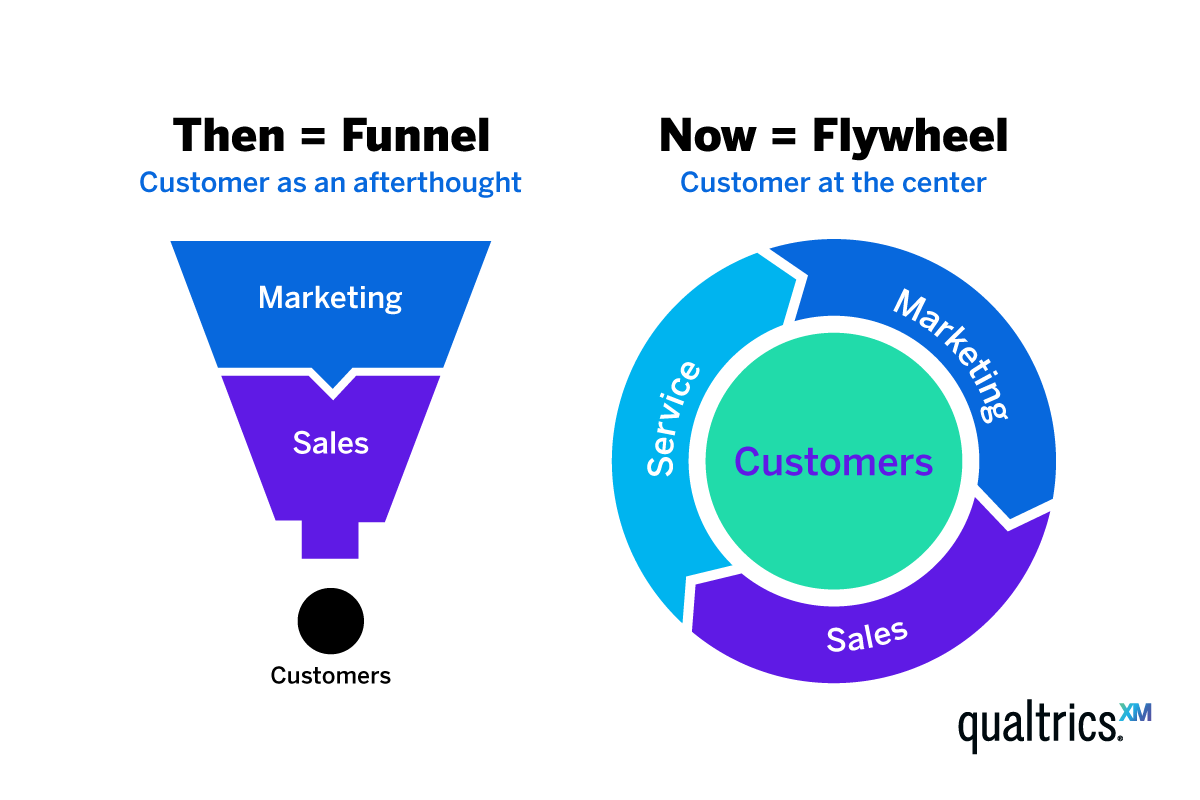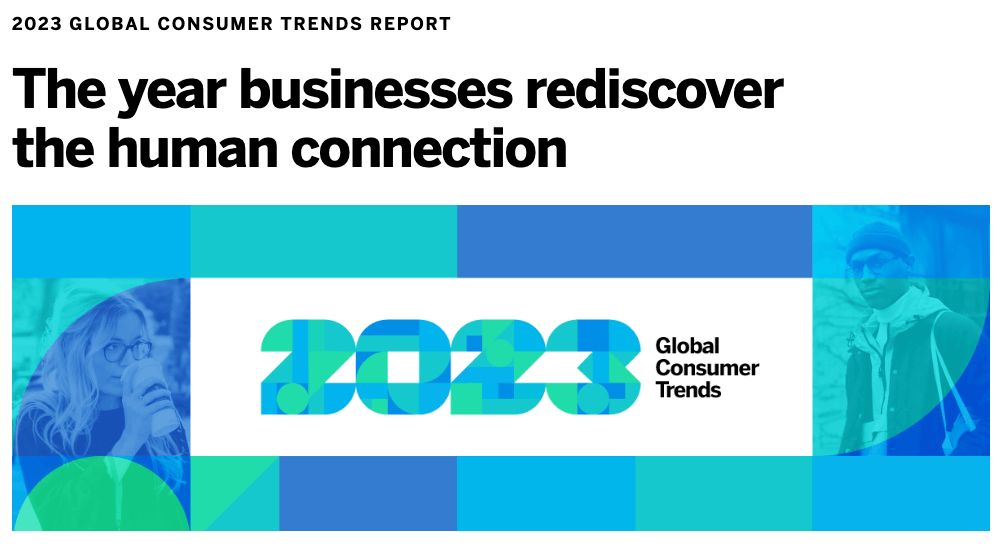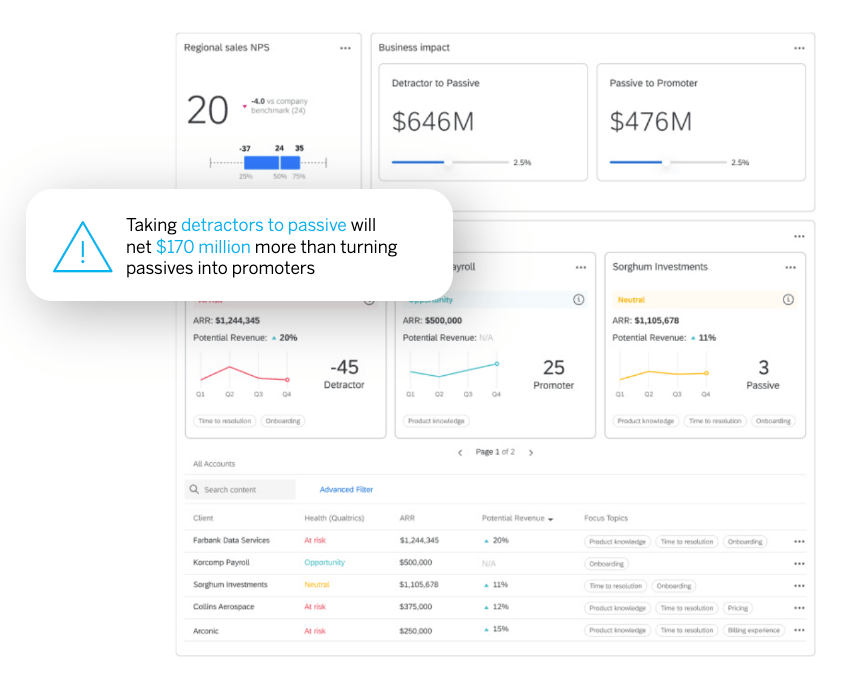What is customer acquisition?
Any time you convince someone to buy your products or services, you’ll have achieved what’s known as customer acquisition. It’s the term given to describe the process of taking a member of your target audience through the steps along the journey toward making a purchase.
But customer acquisition isn’t a passive exercise or just the label we give to that completed journey.
Instead, you acquire customers through a curated, sustainable, and repeatable strategy that nurtures your prospects as they move along the purchasing funnel from awareness, through consideration, and on to the decision stage.
In short? Customer acquisition is the process behind winning new business – it’s how you’ll turn prospective customers into happy purchasers.
Learn how to increase customer acquisition with Qualtrics.
Customer acquisition vs marketing
Hang on, though… doesn’t the above also describe marketing? Well, yes and no, but there’s a key distinction between customer acquisition and marketing: the latter is part of the former. That is, marketing is part of customer acquisition. And it’s the same story for lead generation and sales, too.

In other words, your marketing spend forms part of your customer acquisition strategy. So if a given campaign, display ad, or piece of content is designed to attract people to your brand and make them consider your products, customer acquisition describes both that process and what happens after.
If we’re thinking in terms of the traditional sales funnel, marketing tends to sit near the top – awareness and consideration – while customer acquisition is the strategy that shapes the entire journey.
Customer acquisition vs customer retention
As a business with finite resources, you might feel like there’s a tug of war in terms of priority between customer acquisition and customer retention. The former is about winning new customers, while the latter is about keeping the ones you’ve got.
In reality, they’re both as important as each other.
A lot of organisations fall into the trap of thinking that converting more new customers is the most important thing to focus on. And, sure growth is great. But if your customer acquisition strategy comes at the expense of looking after the customers you’ve already got, you’re in trouble.
And that’s for one big reason:
The funnel is actually circular

The sales funnel doesn’t end with conversion, and it’s not a straight line. Instead, existing customers should be nurtured into becoming advocates for your brand that can feed the beginning of the process for someone else.
With the right care at every stage of the customer experience, existing customers can become a valuable assets that you can leverage in your customer acquisition strategy.
Why is customer acquisition so important for businesses?
There’s an obvious answer to this – that you need new customers to keep growing – but let’s rephrase the question slightly. If customer acquisition is a given, let’s instead ask: why does it need to be thought about so carefully?
Well, the answer is: customer acquisition is a tough and expensive process. It costs as much as 7x more to acquire new customers than it does to keep the ones you have, for one thing.
- The probability of selling to a new customer: 5-20%
- The probability of selling to an existing customer: 50-70%
Those are startling statistics – especially when seen through the lens of the tough economic climate we’re experiencing at the moment. But what’s important is recognising that this crucial, important part of your growth is always going to be an uphill struggle.
And that means it’s vital that you think of customer acquisition as a proactive strategy, rather than a reactive metric.
Doing so will pay off. Research shows that companies who align sales and marketing, for example, save some 30% on their overall customer acquisition cost.
We’ve already mentioned that your customer acquisition efforts should work alongside your customer retention strategy to help form a more circular sales funnel, but only 40% of organizations treat each strategy with equal weighting. Get it right, then, and you’ll stay ahead of the pack.
What is a customer acquisition channel?
You can think of customer acquisition channels as the train tracks that your various strategies travel on to get to your customers. They’re how your activations, campaigns, and tactics find your audience.
Each customer acquisition channel can play host to a range of different strategies, but – given that customer acquisition costs can be expensive – it pays to choose where you spend your resources based on the demographic and behavior of your prospective customers.
The five main customer acquisition channels are:
● Search
● Social media
● Traditional media advertising
● Events
1. Search
Google is the front door to most of the internet for the majority of users, so it makes sense that being able to rank highly on search engine results pages (SERPs) – being one of the first things people see in response to their queries – can help a business make a case for itself.
There are two ways to do this: either by mastering search engine optimisation (SEO) best practices to rank highly organically or through paid search ads. Naturally, the former is cheaper than the latter, but ranking highly using SEO is a long game, taking time and effort to make meaningful strides.
2. Social media
Similarly, there are two ways to get your brand or products in front of potential new customers on social: through rich, shareable, and interesting content, or with paid placement in users’ feeds.
Paid social media can help businesses find eyeballs for their marketing efforts in a more extradited way, but – again – it can be more powerful to work on crafting a social media presence that wins hearts and minds through its own merit.
3. Email
Email marketing remains a really powerful way to deliver your messaging – and to deliver it where it counts: right into prospective customers’ inboxes. There are a bunch of different ways to collect a list of email addresses from members of your target demographic, and these recipients will usually be easier sells than completely cold leads.
That’s because, by giving you their email details, they’ve shown that they already have at least a passing interest in your business.
4. Traditional media advertising
TV, radio, print, out-of-home. These platforms are much harder to track the success of than digital marketing efforts, but they’re still strong channels for delivering a robust, multi-channel campaign that people remember through attritional absorption.
Cost is the biggest barrier here; many brands simply can’t afford to promote themselves with such a blanket approach, or in mediums that typically cost more than piecemeal digital approaches.
5. Events
Webinars, conferences, panels, or other kinds of industry-specific events can be powerful channels for delivering your product messaging in a way that also offers educational or networking benefits to attendees.
Hosting these kinds of events also helps position your business and your people as thought leaders in the space, raising your profile and helping build influence while gathering contact details for potential leads at the same time.
How to create a customer acquisition strategy
The key to building a customer acquisition strategy that generates growth is to strike a balance between two important characteristics: flexibility and sustainability.
Flexibility means understanding that things change. Consumer habits, opinions, and behaviours are always evolving, which means that what works today might not work tomorrow. At the same time, finding a set of strategies that work, and are repeatable, is how you’ll keep your customer acquisition cost down.
Exactly how you toe that line will depend on a wealth of circumstances unique to your business, but what we can offer are a few top-level strategies that we know work wonders:
7 proven customer acquisition strategies
1. Think long-term with content marketing
Content marketing is not a quick win. What it is instead is an exceptional way to build influence and grow share of voice over a long period of time. Writing content with SEO in mind will help you rank organically for the things your potential customers are looking for. Growing your social media accounts with original content that people will actually want to share will take time. Building buzz around your C-suite as LinkedIn thought leaders will take many months and dozens of long-form posts.
Many brands bow out of the content marketing race before it’s even begun. Success here will mean customers acquired through attrition – powered by a longtail plan for content that slowly builds your business’s online presence.
Example: Buffer
Buffer puts its money where its mouth is by being a social media tool that offers up-to-the-minute news and opinions on the social landscape across no fewer than four different blogs and two regular podcasts.
2. Meet your audience where they are
You need to be careful with how you use your teams’ time and budget during the customer acquisition process. To do that, you’ll want to understand where your customers are, and how best to reach them. The demographic groups that use Facebook daily, for instance, are likely to be vastly different from the ones using TikTok, or LinkedIn, or who listen to their favorite podcasts religiously.
Keeping your customer acquisition cost low means being thoughtful about where you spend your marketing and sales dollars, and using customer data to help you prioritise.
Example: BMW
“Blown away. Kudos BMW, keep doing what you are doing!” That’s one of the many five-star reviews on Apple Podcasts for BMW’s 6-part narrative audio drama Hypnopolis – which weaves futuristic BMW technology into a gripping story people will actually want to listen to.
3. Publish customer stories and UGC
You can build a positive reputation among customers new and old alike by shining a light on your success stories. Maybe that’s through sharing social media posts in which your customers sing your praises, or maybe it’s through curated customer case studies where you interview some of your biggest clients.
Either way, people are naturally more trusting of businesses that already have happy customers, so using user-generated content and testimonials to your advantage can help with both finding new customers, and building customer lifetime value.
Example: Adobe
Ok, so Adobe might have an innate advantage here, but even so… You can’t knock the company’s ability to take content generated by users and turn it into a showcase for its products. Adobe’s Instagram account highlights what Photoshop and the like can do, as demonstrated by the people who pay for it.
4. Utilise gated assets
A gated asset is a piece of marketing collateral that your customer will find helpful, but which is locked behind a form that requires their email address. Normally, these are guides, eBooks, industry reports, or webinar events. The goal is to collect those email addresses and use them to build out your lead generation pipeline with a calendar of curated content and offers.
Email can be a powerful marketing and sales tool, but getting people to open and read your emails is never easy. The best approach is to use A/B testing to fine-tune what works and ditch what doesn’t, over the long term.
Example: Qualtrics
We at Qualtrics create a Global Consumer Trends report on an annual basis, which takes stock of the consumer experience industry as a whole, and lifts the lid on the trends that will shape the year to come. This, alongside our annual X4 event, is a gated asset that not only provides readers with useful info but helps us collect details for people who might be interested in our products.

5. Design a powerful referral program
Sometimes your existing, paying customers can become one of your most powerful customer acquisition strategies. Referral schemes are a great way to empower your loyal customers to spread the word and find new customers for you, with mutually-beneficial discounts baked into the referral.
Commonly, this kind of ‘refer a friend’ scheme aims to get people to sign up for subscription-based services – where the referrer gets some money off alongside new customers – but it can also be aimed at one-off purchases. You’ll often find the latter exemplified by YouTubers of podcasters offering discounts via a promotional code.
Example
Meal replacement product Huel has grown massively by leveraging the power of referrals. Friends referring friends receive $10 off their next order, as does the newly-acquired customer. It’s simple but hugely effective.
6. Go freemium, or offer free trials
When you invite customers through the door and let them play with what you’ve got to offer for free, a decent percentage will stick around. That’s why an increasing number of SaaS companies either offer a freemium pricing structure or lengthy free trials.
The idea is to get you hooked on the product and grow your business over time. Or, alternatively, it’s a tactic designed to get consumers to use products in their personal life that they can then recommend to their employers.
Example: Gmail
Gmail and Google’s Workspace suite of apps work in tandem. Millions of people use Gmail for their personal email account, for free, which allows them to grow familiar with the product. They then might, over time, need to then subscribe for more storage. Or, as is Google’s hope, as and when those people become decision-makers in IT positions, they’ll be inclined to go with Google as their business suite solution through familiarity.
7. Build a best-in-class customer experience
Ultimately, the best way to attract new customers is to offer a brilliant, unforgettable experience at every stage of the customer journey. While it’s sometimes easy to acquire customers with a memorable set of interactions, it’s harder to keep them delighted as they move along the path toward being an advocate.
Surprise discounts, reward programs, personalised messaging, exceptional customer experience, and lighting fast support all make for customers who can’t wait to tell people how great you are to do business with. And that reputational boost can work harder for you than all of the more traditional customer acquisition channels combined.
Example: Apple
Yep, another list in which Apple is cited as a best-in-class example. But it’s for good reason. Every experience customers have with the brand, from scrolling through product pages to shopping in-store, to booking a Genius Bar appointment, is either exciting, personal, professional, inspiring, or a mix of all of the above. That kind of care and attention is how you build a reputation that boosts your customer acquisition efforts.
How to measure customer acquisition
The success of your customer acquisition strategy will be evident in the amount of new business you experience in a given timeframe. But what’s more important is to look at how much all those new customers actually cost you to accrue, and how much revenue those customers might bring you in future.
That’s because, when you think about it, customer acquisition techniques that bring in scores of new customers aren’t sustainable if each one spends less than it took to attract them in the first place.
To keep tabs on that, we look at two core metrics:
Customer acquisition cost (CAC)
Customer acquisition cost (CAC) is how much it cost you to net each new customer. You can look at this in terms of marketing and sales spend, or as a more total value that also incorporates things like salaries and operational expenses.
In general, though, the idea is the look at a period of time – like a quarter or financial year – and divide the cost of your marketing efforts by the number of new customers you’ve won. The aim of the game? To keep your customer acquisition costs as low as possible.
For a full overview, check out our full guide to customer acquisition costs.
Customer lifetime value (CLV)
Customer lifetime value (CLV) digs into the details of each customer to determine if winning their business will outweigh your customer acquisition costs.
Think of it like this: If your customer acquisition cost is $100 per customer, then you’ll want to be sure that your customer lifetime value is more than $100 – that is, that those customers will spend more than $100 with you over the length of the relationship. If it’s less, you’ll be running at a loss.
For a full overview, check out our full guide to customer lifetime value.
With both metrics, there are a couple of things to keep in mind. Firstly, while you may have a high customer acquisition cost in a given period, that doesn’t suggest it’ll always be that way. Sometimes, for example, you need to up your marketing costs during a specific quarter, in a way that’ll pay off over time.
Secondly, CLV naturally varies hugely by industry and product type. For example, a customer might really love Coca-Cola, but even if they drink one can every single day for their entire life, they still won’t spend as much as a person who buys a single Tesla. What really matters is the margin between operational and marketing costs, and the profit each customer can net your business.
Customer acquisition: The bigger picture
Having more customers will never be a bad thing. It means more revenue, more growth, and more opportunity to win over yet more customers. But it’s not the be-all, end-all of modern business.
Today’s consumers are more demanding than ever; they expect excellence at every stage. In practice, that means seeing customer acquisition as one part of the overall customer experience.
Curating a robust and sustainable customer acquisition strategy that wins over new customers is a fantastic and worthwhile practice, but it will ultimately lead to naught if you don’t then follow that up with a customer experience that matches the quality they were presented with upfront.
How many times have you had this happen to you in the past: you’re wowed by a great introductory offer and treated like royalty, only to then be left hanging with poor customer service, inflating renewal prices, and lackluster support once you’re through the door?

In a tough economic climate, businesses that thrive do so because they understand how customer acquisition and retention make for a cyclical ecosystem.
You’ll need to use tools that can help you listen to your existing customers, understand what they’re saying, and empower customer support teams to blow people away with your level of aftercare.
Great customer experience is all about identifying and closing gaps between customers’ expectations and the reality of what you’re offering.
And to do that, you’ll need customer experience software that can listen, understand and uncover insight for you, 24/7, across every digital touchpoint. That’s where Qualtrics, with its powerful customer experience management platform, can help.
Increase customer acquisition with Qualtrics